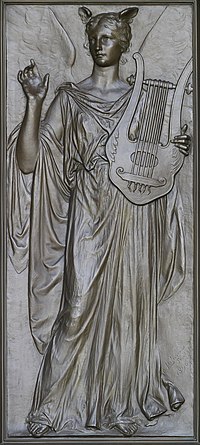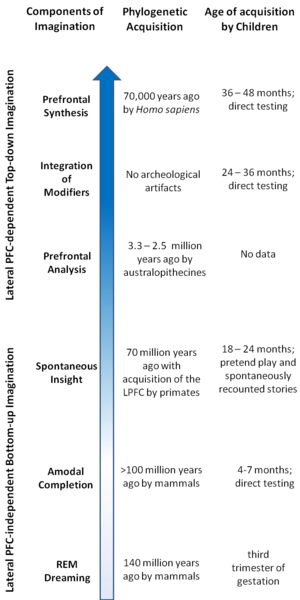Imagination

Imagination is the production of
One view of imagination links it with cognition,[10] seeing imagination as a
The cognate term, "mental imagery" may be used in
Imagination, however, is not considered to be exclusively a cognitive activity because it is also linked to the body and place, particularly in that it also involves setting up relationships with materials and people, precluding the sense that imagination is locked away in the head.[14]
Imagination can be expressed through stories and writings such as
History
Imaginatio is the standard Latin translation of the Greek term phantasia.[17] Aristotle in On the Soul considered phantasia (imagination) as the capacity for making mental images, and distinguished it from perception and from thinking. He held however that thought was always accompanied by an image.[18]
The notion of a "mind's eye" goes back at least to Cicero's reference to mentis oculi during his discussion of the orator's appropriate use of simile.[19] Cicero observed that allusions to "the Syrtis of his patrimony" and "the Charybdis of his possessions" involved similes that were "too far-fetched". He advised the orator to, instead, just speak of "the rock" and "the gulf" (respectively) — on the grounds that "the eyes of the mind are more easily directed to those objects which we have seen, than to those which we have only heard".[20]
In medieval
The concept of "mind's eye" appeared in English in
Galileo used the imagination to conduct thought experiments, such as asking readers to imagine in what direction a stone released from a sling would fly.[23]
Description
Imagination... is more important than knowledge. Knowledge is limited. Imagination encircles the world.
When I get an idea I start at once building it up in my imagination. I change the construction, make improvements and operate the device in my mind. It is absolutely immaterial to me whether I run my turbine in thought or test it in my shop. I even note if it is out of balance. There is no difference whatever, the results are the same. In this way I am able to rapidly develop and perfect a conception without touching anything.
Imagination involves a creative division of the mind which is used to develop theories and ideas based on functions. Drawing from actual perceptions, imagination employs intricate conditional processes that engage both Semantic and Episodic memory to generate fresh or refined ideas.[26] This part of the mind helps develop better and easier ways to accomplish old and new tasks.
In sociology, imagination serves as a means to depart from reality and gain insights into social interactions from an external perspective. This leads to the development of theories through questions that would not otherwise be asked. These speculative ideas can be safely explored within a virtual realm and then, if deemed feasible and the function is true[clarification needed], translated into real-world applications.
Imagination can be classified as:
- involuntary (encompassing sleeping dreams)
- voluntary (encompassing daydreaming, reproductive imagination, creative imagination, and the dream of perspective[clarification needed])
Psychology
Psychologists have studied imaginative thought, not only in its exotic form of
The phenomenology of imagination is discussed in The Imaginary: A Phenomenological Psychology of the Imagination (French: L'Imaginaire: Psychologie phénoménologique de l'imagination), also published under the title The Psychology of the Imagination, a 1940 book by Jean-Paul Sartre, in which he propounds his concept of the imagination and discusses what the existence of imagination shows about the nature of human consciousness.[31]
The imagination is also active in our perception of photographic images in order to make them appear real.[32]
Memory
Memory and mental imagery, often seen as a part of the process of imagination, are affected by one another.[33] "Images made by functional magnetic resonance imaging (fMRI) technology show that remembering and imagining sends blood to identical parts of the brain."[33]
Various psychological factors can influence the brain's ability to retain information as either long-term memories or short-term memories. Experiences stored as long-term memories are easier to recall, as they are ingrained deeper in the mind[
Perception
Piaget posited that a person's perceptions depend on their world view. The world view is the result of arranging perceptions into existing imagery by imagination. Piaget cites the example of a child saying that the moon is following her when she walks around the village at night. Like this, perceptions are integrated into the world view so that they make sense. Imagination is needed to make sense of perceptions.[36]
Brain activation
A study that used
Evolution

Moral imagination
Moral imagination usually describes the mental capacity to find answers to ethical questions and dilemmas through the process of imagination and visualization. Different definitions of "moral imagination" can be found in the literature.[44]
The philosopher Mark Johnson described it as "[a]n ability to imaginatively discern various possibilities for acting in a given situation and to envision the potential help and harm that are likely to result from a given action."[45]
In one proposed example, Hitler's assassin Claus von Stauffenberg was said to have decided to dare to overthrow the Nazi regime as a result (among other factors) of a process of "moral imagination." His willingness to kill Hitler was less due to his compassion for his comrades, his family, or friends living at that time, but from thinking about the potential problems of later generations and people he did not know. In other words, through a process of “moral imagination” he developed empathy for "abstract" people (for example, Germans of later generations, people who were not yet alive).[46]
See also
- Artificial imagination – Artificial simulation of human imagination
- Body of light – Hermetic starfire body
- Cognitive dissonance – Stress from contradictory beliefs
- Creative visualization – Purposeful visualisation for neuropsychological, physiological or social effects
- Creativity – Forming something new and somehow valuable
- Decatastrophizing – Cognitive restructuring technique to treat cognitive distortions
- Exaggeration – Statement that represents something in an excessive manner
- Fantasy (psychology) – Mental faculty of drawing imagination and desire in the human brain
- Fictional countries– Country that exists only in fiction and not in reality
- Guided imagery – Mind-body therapy
- Imagery – Author's use of vivid and descriptive language to add depth to their work
- The Imaginary (psychoanalysis) – Term in Lacanian Psychoanalysis
- Imaginary (sociology) – set of values, institutions, laws, and symbols through which people imagine their social whole
- Imagination Age– Era of humanity after the information age
- Imagination inflation – Type of memory distortion
- Intuition (psychology)– Ability to acquire knowledge, without conscious reasoning
- Philosophy – Study of general and fundamental questions
- Magic realism – Style of literary fiction and art
- Mental image – Representation in the mind of objects, activities or events, whether they existed or not
- Mimesis – Communication by means of imitation
- Royal Commission on Animal Magnetism – 1784 French scientific bodies
- Sociological imagination – Type of insight offered by the discipline of sociology
- Truth – Being in accord with fact or reality
- Tulpa – Entity manifesting from mental powers
- Verisimilitude – Resemblance to reality
References
- ^ "Mental Imagery". The Stanford Encyclopedia of Philosophy. Metaphysics Research Lab, Stanford University. 2021.
- ISBN 9781870736107.
To imagine is to form experiences in the mind. These can be recreations of past experiences as they happened such as vivid memories with imagined changes, or they can be completely invented and possibly fantastic scenes.
- ^ a b Norman, Ron (2000). "Cultivating Imagination in Adult Education". Proceedings of the 41st Annual Adult Education Research: 1–2.
- ^ Sutton-Smith, Brian (1988). "In Search of the Imagination". In Egan, K.; Nadaner, D. (eds.). Imagination and Education. New York: Teachers College Press. p. 22.
- ^ Archibald MacLeish 1970, p. 887
- Egan, Kieran(1992). Imagination in Teaching and Learning. Chicago: University of Chicago Press. p. 50.
- S2CID 233645071.
- ^ Frye, Northrop (1963). The Educated Imagination. Toronto: Canadian Broadcasting Corporation. p. 49.
- ^ As noted by Giovanni Pascoli.
- ISBN 9780807742181. Retrieved 6 October 2022.
Like feelings and emotions, imagination is a prickly topic with a history of exclusion from the realm of the cognitive.
Visual imagery typically refers to the voluntary creation of the conscious visual experience of an object or scene in its absence (e.g. solely in the mind). [...] imagery can play a core role in many anxiety disorders, depression, schizophrenia and Parkinson's disease, and is increasingly harnessed as a uniquely powerful tool for psychological treatment [...].
Rational thought and imaginative thought may be based on the same kinds of cognitive processes, processes that underpin thinking about possibilities.
Basically what this means is that the children use their make-believe situation and act as if what they are acting out is from a reality that already exists even though they have made it up.imagination comes after story created.[page needed
Further reading
- Books
- Byrne, R. M. J. (2005). The Rational Imagination: How People Create Alternatives to Reality. Cambridge, MA: MIT Press
- Fabiani, Paolo "The Philosophy of the Imagination in Vico and Malebranche". F.U.P. (Florence UP), Italian edition 2002, English edition 2009.
- Salazar, Noel B. (2010) Envisioning Eden: Mobilizing imaginaries in tourism and beyond. Oxford: Berghahn.
- Wilson, J. G. (2016). "Sartre and the Imagination: Top Shelf Magazines". Sexuality & Culture. 20 (4): 775–784. S2CID 148101276.
- Articles
- Salazar, Noel B. (2020). On imagination and imaginaries, mobility and immobility: Seeing the forest for the trees. Culture & Psychology 1–10.
- Salazar, Noel B. (2011). "The power of imagination in transnational mobilities". Identities: Global Studies in Culture and Power. 18 (6): 576–598. S2CID 143420324.
- Watkins, Mary: "Waking Dreams" [Harper Colophon Books, 1976] and "Invisible Guests - The Development of Imaginal Dialogues" [The Analytic Press, 1986]
- Moss, Robert: "The Three "Only" Things: Tapping the Power of Dreams, Coincidence, and Imagination" [New World Library, September 10, 2007]
- This article incorporates text from a publication now in the public domain: Chisholm, Hugh, ed. (1911). "Imagination". Encyclopædia Britannica. Vol. 14 (11th ed.). Cambridge University Press. pp. 304–305.
Three philosophers for whom imagination is a central concept are Kendall Walton, John Sallis and Richard Kearney. See in particular:
- ISBN 0-674-57603-9(pbk.).
- John Sallis, Force of Imagination: The Sense of the Elemental (2000)
- John Sallis, Spacings-Of Reason and Imagination. In Texts of Kant, Fichte, Hegel (1987)
- ISBN 0-8166-1714-7)
- Richard Kearney, "Poetics of Imagining: Modern to Post-modern." Fordham University Press (1998)
External links
![]() The dictionary definition of imagination at Wiktionary
The dictionary definition of imagination at Wiktionary
 Media related to imagination at Wikimedia Commons
Media related to imagination at Wikimedia Commons- Imagination on In Our Time at the BBC
- Imagination, Mental Imagery, Consciousness, and Cognition: Scientific, Philosophical and Historical Approaches
- Two-Factor Imagination Scale at the Open Directory Project
- "The neuroscience of imagination". TED-Ed.
